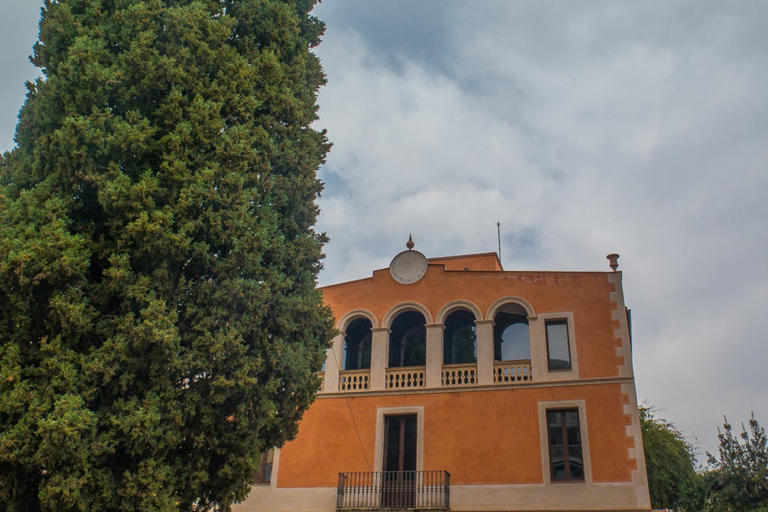
Introduction
Cal Quiteria is one of the few country houses that remain within the urban nucleus. It is located at 6 Vinyoles street, on the corner of the Rambla de Can Mora, today “sandwiched” between buildings. It was built between 1879 and 1884 by Josep Pahissa Claret, and its appearance has not changed much since then, although the windmill and part of the construction that crowned the house have disappeared. All the ornamentation was carried out by Francesc Arpí, from Cal Gerrer, who contributed a handful of elements, such as the balusters, lintels and cornices.
At the end of the 19th century, Sant Cugat wasas experiencing a good economic moment, especially thanks to the wine production. This climate of euphoria caused the population to spread mainly through the area of the Plaçza de Barcelona. Quiteria, oOne of the new constructions was necessary Quiteria, made in the style of athe country house. This house could be considered, therefore, a sample of the indigenous growth of the agricultural town.
Its name comes from the frequent invocations to the saint by José Pahissa Claret’s the son of José Pahissa Claret, who constantly repeated: "Váalgame Santa Quiteria!". This made the house to be known with this namerenown.
On October 6, 1934, when rebels from the Bloque Obrero y Campesino stormed the Sant Cugat Town Hall, the Generalitat sent a platoon of assault guards with orders to shoot at the Casa de la Villa building, which someone described imprecisely in tlike thishis way imprecise: "... upon arrival, the first large house to be seen is the Town Hall ...". The platoon thought that Cal Quiteria was Casa de la Villa and fired at it. Around noon on October 7, the Pahissa family began to hear shotgun shots. The grandson of the founder of the house, Joan Pahissa Villadelprat, who was then 27 years old, explained to Frederic Cabanas, according to the book “Sant Cugat”. Origins and histories of a town and a family were the following: "My brother and I went upstairs, where we showed a white cloth as a sign of peace, and they, thinking that we had surrendered, made a ceasefire."
The book goes on to explain that those men, leaving Cal Quiteria, continued looking for the City Hall, but not with much success either, since they confused it with the Cansaladeria Juliana (San Antonio street corner with Francesc Moragas), and they fired wrongly, this time because as was the tradition in delicatessensas it was the tradition at buchersbutchers’ shops, a red flag was hung in the window to showsignal that the pigs had been killed.
The impacts were visible on the facade of Cal Quiteria for a long time until the current rehabilitation of the building happen..
Once the building is knownOnce we now know the buildigbuilding, we cannot avoid talking about the slender figure of the cypress tree that accompanies the main house. It is known as the Ciprés de Cal Quiteria. It seems like a sentinel who guards the house, being a symbol of hospitality, welcome and spirituality in many manor houses with historical roots in Catalonia.
Formerly, as it is well known, the cypresses waeres considered a symbol of hospitality. Cypress trees were planted at the door of the houses to indicate to the travelers that the house offered them food and sometimes bed and everythingall their necessities. In Catalonia there are a series of traditions, stories and legends that refer to the right of the poor to spend the night and stay in some farmhouses. Thus, if there was a cypress tree in front of the house, it meant that they had the right to a small meal, that isthis being, wine, bread and a little sausage. If there were two, then a full meal could all be expected. And if there were three, it meant that they could also spend the night there..
In most of the houses there were rooms to accommodate temporary workers or other visitors. On the other hand, it was always possible to spend the night in the hayloft. In some regions there are storiesis talk of the "court of the poor", rooms in the country house for this purpose. In fact, the relationship between poverty and the houses began from the moment theyit wereas built; When theyhe opened a house, the first thing they took was bread and money, which were given to the first beggar who showed up. The fulfillment of this ritual was believed to bring prosperity and wealth into the home.
This cypress was originally located on the property of the old Can Quiteria grounds. The house had a large space in front with orchards and trees between the façadefacade and the Can Mora stream, and between the streets of Vinyoles and Girona. The cypress tree stood on the corner of Carrerlle de Girona and in front of the Rambla de Can Mora. In February 2004, the square was urbanized and an underground parking garage was built, and as a consequence, all this space and the cypress tree were affected by the workslabors that happened. The City Council, through specialists and arboriculturists and the urban developer, moved the cypress and a voluminous land mass with two large demountable cranes at the other end of the square, in front of the manor house, where the Plaçza de Can Quiteria currently presides.